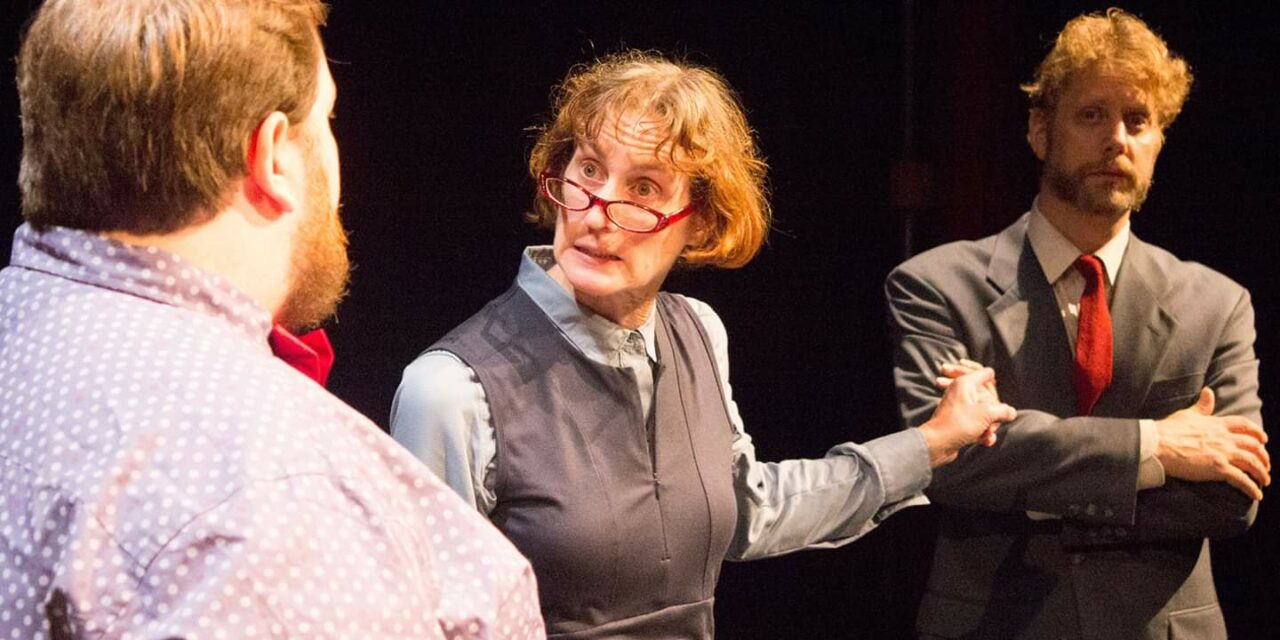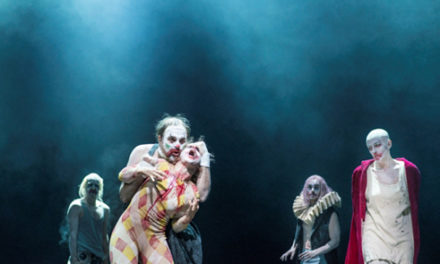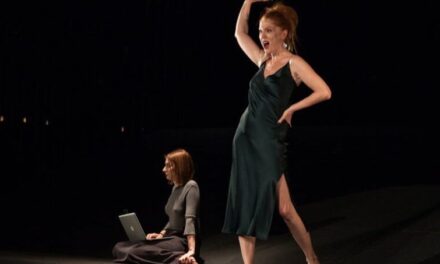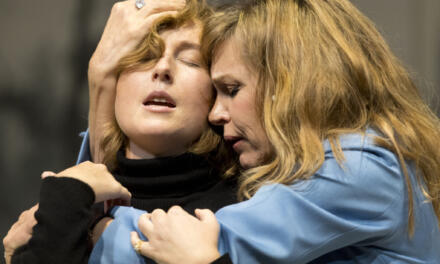Marius von Mayenburg, author of The Ugly One, representing the new young German Theatre, is performed here in the English translation by Maya Zade, the version used for the creation at the Royal Court Theatre in London in 2008. Mayenburg–as a translator himself, interested in the works of the late Sarah Kane–is in close contact with the similar world of the younger generation of British playwrights (Sarah Kane, Caryl Churchill, Martin Crimp, Mark Ravenhill) who all have had a strong influence on the Berliner Schaubühne thanks to artistic director Thomas Ostermeir’s interest in their work. This play hides a deeper reflection on social interaction without delving into psychological or psychoanalytical study of character and that is no doubt the most difficult obstacle for a less experienced cast to overcome.
Unfortunately, this new Plosive production of the Ugly One at the Gladstone lacked a director with a clear vision of staging that might have given more strength to this well-constructed and powerful play, whose uncomfortable humor was at the basis of what began as a Hegelian parable ending in a tragicomic caricature of universal values.
It all takes place on David Magladry’s minimalist set. There is a long table (that morphs into a surgeon’s table and various other spaces ); there are chairs and mirrors placed at different angles on the wall supposedly giving various perspectives of the stage. David Magladry, the set and lighting designer, created a background of emotional and evocative sounds but it lacked a creative use of lighting to highlight many of the defining moments of the drama. That absence was sorely felt.
Young engineer Lette played by David Whiteley, when he is suddenly confronted with the destructive gaze of his entourage in his workplace, is transformed into a man who had never noticed his own ugly face. When he learns his assistant Karlmann is going to present his recent scientific invention at an international conference because his own face is deemed too ugly to convince anyone to buy his product, his boss (Sacha Dominique) tells him the truth point-blank as though it was a clear fact, as does his wife (Julie Le Gal) in more gentle terms. The result: his fate is sealed.
Lette and his wife go to a plastic surgeon who will rebuild the disturbing face (which was never intended to have any material presence on stage). After much horrid grinding and scraping and screechingly inhuman but very limited use of sound and light, a bandaged Lette stands before us like a robot, or the “invisible man,” straight out of the horror movies, until the surgeon (also played by Sacha Dominique whose over the top style of joking and nervous hand waving suggested she was in a different play) removes the bandages and with a cry of disbelief, tells us that Lette has become a perfect male specimen whom all will want to possess and imitate. Of course, the actor’s faces remain the same, but the gaze of the others and the unfailing discourse of the observers make it all true. This is about internalizing the gaze of others that creates one’s sense of identity and the notion to which Fanon speaks so eloquently (inspired by Sartre) in his essay “Black skin White mask” to explain the disturbing racial relations in the context of colonization. As the play evolves, the principal character becomes more and more narcissistic as people desire to possess his beautifully reconstructed face.
From that moment on, the function of the director becomes absolutely central. This face, seen as the height of beauty, becomes a new sign of economic and sexual success, and the play moves to a new level in its evolution. The face becomes a highly desirable consumer-object, a cultural object commodified by its market value and this now becomes a play about capitalism and its relationship with culture. The Surgeon suddenly anxious to get into private business, is now ready to operate on anyone willing to pay her to reproduce Lette’s face.
Sexual pressures come into play. Tarana Burke’s “Me Too” movement (much later it became #MEtoo) came into being in 2006 while The Ugly One appeared in 2007 one year later as Lette is pursued by the new Administrator of the firm, an extremely fit 70-year- old marvel whose body has been kept in shape by successive operations. Lette who is rehired by the firm must now perform his new role as the lover of this woman and her own gay son who also overplays his role and turns it into a caricature. Julie Le Gal as Lette’s faithful wife Fanny, also performs the 70-year-old-marvel but she too has trouble shifting from one role to the next and this whole source of binary tension between the roles signifying the shifting identities involves Andrew Hosale, Judi Le Gal, and Sasha Dominique becomes barely identifiable because they do not dominate the changes.
This is all the more obvious the moment when consumerism gives way to the chilling metaphysical realization that the pleasure of being imitated has backfired and that Lette’s own sense of identity has become terribly fragile in this sea of sameness where the difference is almost eliminated. How does he operate in this mass of interchangeable faces where everyone resembles everyone else–“me” and “I” and “you” cease to exist.
The solid dramaturgical construction of this piece was quickly obvious but what lacked was the vision of a director who imposed a clear orchestration of the way the actors’ used their bodies and the way they spoke. That was the main obstacle that ended in a play with no tension, no drama, no excitement. Nothing meshed. One almost felt that those in charge barely heard the dialogue. Even the shifting voices of the actors who became protagonists in a binary relationship were barely identifiable. It seemed as though the director did not try to impose a vocal (not musical) score that would have helped the actors reach new heights of performance, by going way beyond the idea that these roles had something to do with a naturalistic acting style, linked to a former state of mind or past experience. They might have become purely obedient bodies, working with a director who helped them invent a completely new style of vocal score which gave examples of new inspiration for the spoken word. If this was done it was unfortunately not obvious and this wonderfully constructed play fizzled leaving us very disappointed.
This production continues at the Gladstone from September 26 to October 5, 2019.
The Ugly One by Marius Von Mayenburg. Translated from the German by Maya Zade
Directed by Peter Haworth
Scenic and lighting design by David Magladry
This article was originally published on http://capitalcriticscircle.com/ on September 28, 2019. Written by Alvina Ruprecht. Reposted with permission. Read the original article.
This post was written by the author in their personal capacity.The opinions expressed in this article are the author’s own and do not reflect the view of The Theatre Times, their staff or collaborators.
This post was written by Alvina Ruprecht.
The views expressed here belong to the author and do not necessarily reflect our views and opinions.


















